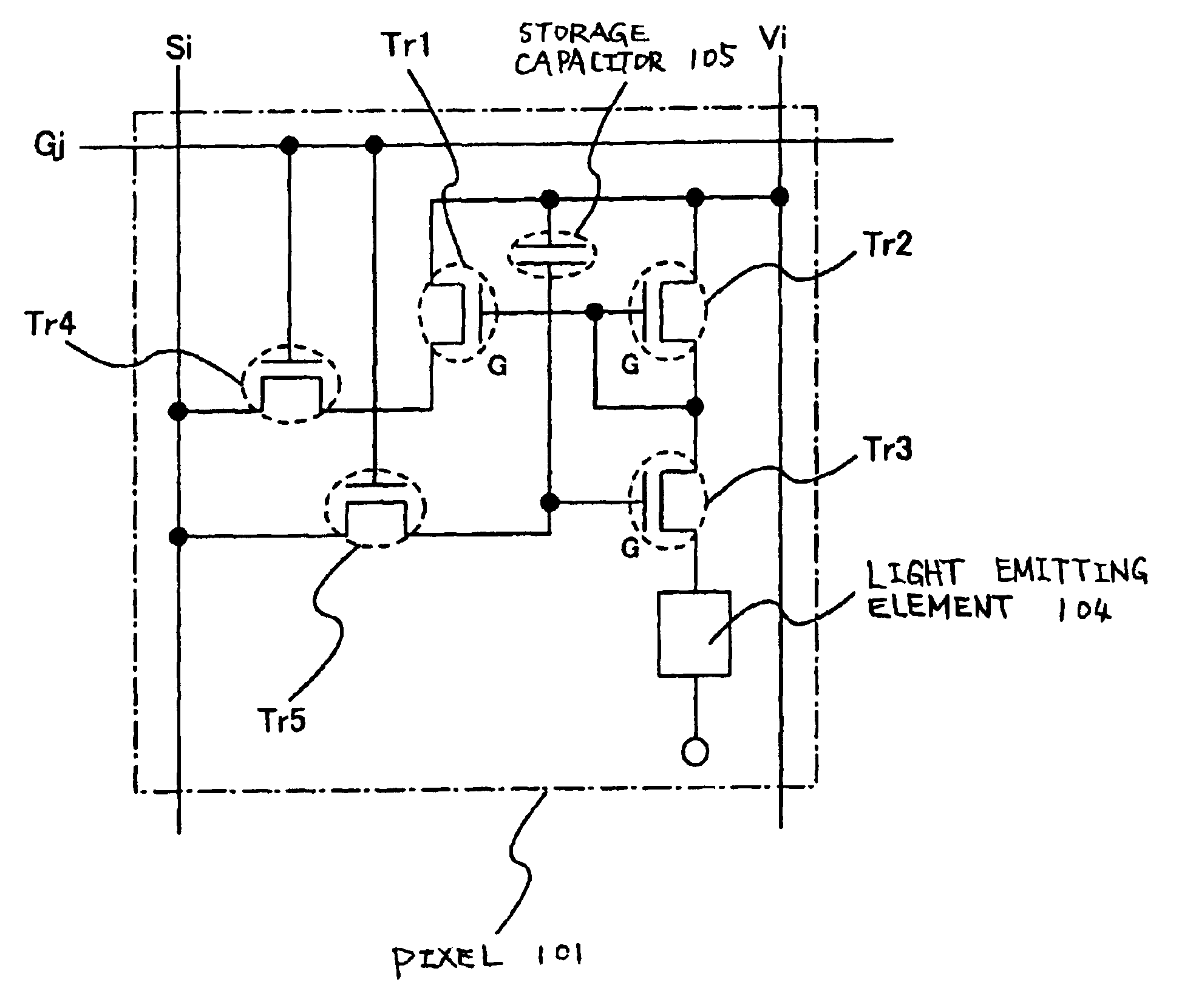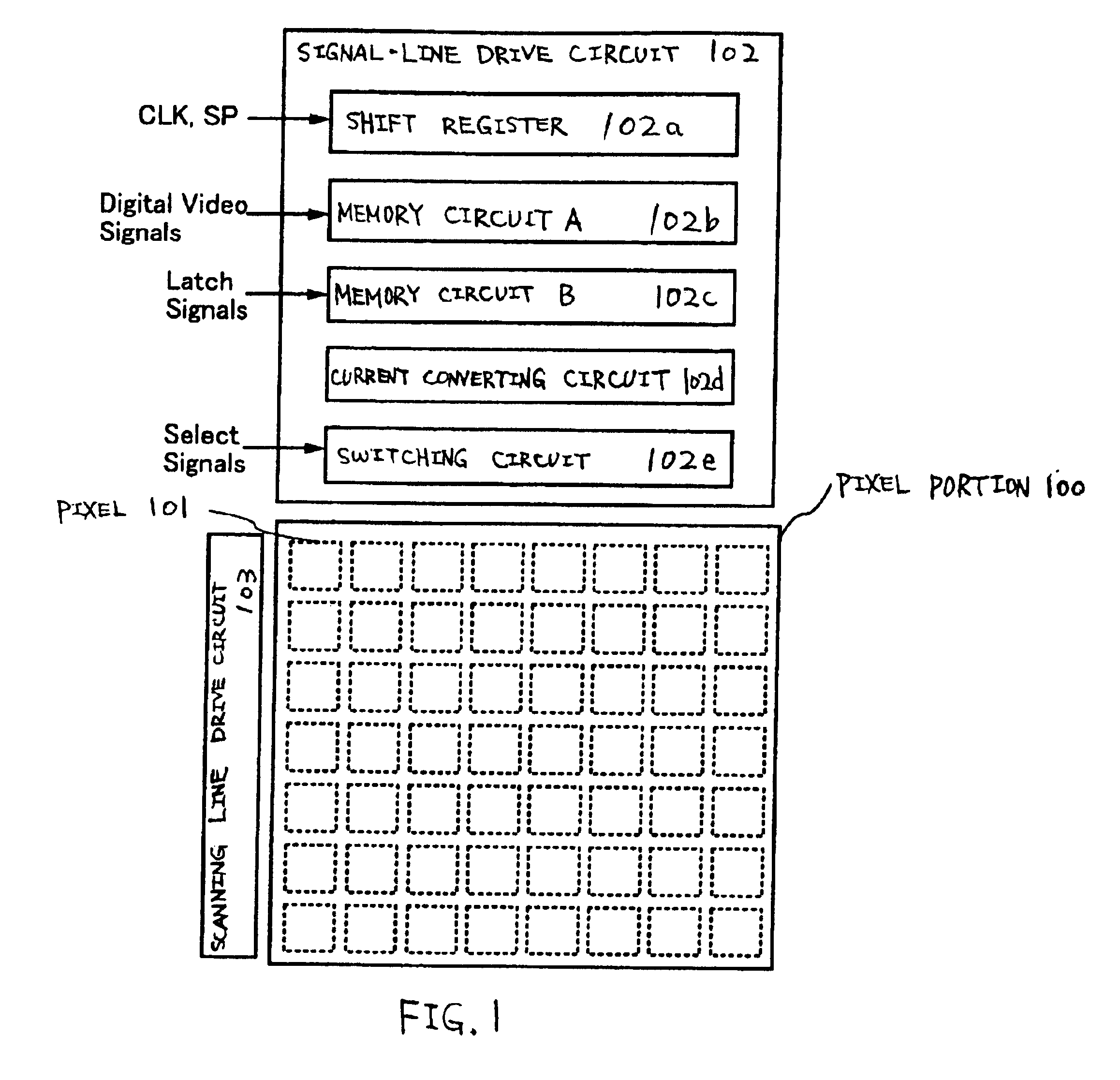Light emitting device, driving method of light emitting device and electronic device
a technology of light emitting device and electronic device, which is applied in the direction of static indicating device, electroluminescent light source, instruments, etc., can solve the problems of easy dispersion of characteristics, short life of oled due to organic luminescent layer deterioration, and inability to compare the electric characteristics of tft utilizing polysilicon, etc., to prevent the luminance of light emitting element from dispersing, constant luminance, and prevent the effect of light emi
- Summary
- Abstract
- Description
- Claims
- Application Information
AI Technical Summary
Benefits of technology
Problems solved by technology
Method used
Image
Examples
example 1
Taking a pixel shown in FIG. 2 for example, description on this example refers to a case in which the inverse biasing period Ti is made to appear based on a timing that differs from that shown in FIG. 4. Referring now to FIG. 5, a drive method according to this example is described below.
FIG. 5 exemplifies a timing chart of a voltage applied to individual scanning lines, a voltage applied to the power supply line, and a voltage fed to a light emitting element in a pixel (i, j) in this example. FIG. 5 exemplifies a case in which the transistors Tr1 Tr2 and Tr3 are composed of p-channel type TFTs, whereas the transistors Tr4 and Tr5 are both composed of n-channel type TFTs.
It is defined that the total length comprising the write in periods Ta1-Tan and the display periods Td1-Tdn corresponds to T — 1 and a potential difference between the power supply line Vi and an opposing electrode of the light emitting element during the writing and display periods is expressed as V — 1. Further, d...
example 2
Taking a pixel shown in FIG. 2 for example, description on this example refers to a case in which the inverse biasing period Ti is made to appear based on a timing that differs from those shown in FIGS. 4 and 5. Referring now to FIG. 6, a drive method according to this example is described below.
FIG. 6 exemplifies a timing chart of a voltage applied to individual scanning lines, a voltage applied to the power supply line, and a voltage fed to a light emitting element in a pixel (i, j) in this example. FIG. 6 exemplifies a case in which the transistors Tr1, Tr2 and Tr3 are all composed of p-channel type TFTs, whereas the transistors Tr4 and Tr5 are both composed of n-channel type TFTs.
In this example, immediately after termination of individual display periods Td1-Tdn, in other words, immediately after terminating individual sub-frame periods, the inverse biasing periods Ti1-Tin respectively appear. For example, while the m-th sub-frame period SFm remains (where m corresponds to an o...
example 3
Taking a pixel shown in FIG. 2 for example, description on this example refers to a case in which the inverse biasing period Ti is made to appear based on a timing that differs from those shown in FIGS. 4 to 6. Referring now to FIG. 7, a drive method according in this example is described below.
FIG. 7 exemplifies a timing chart of a voltage applied to individual scanning lines, a voltage applied to the power supply line, and a voltage fed to a light emitting element in a pixel (i, j) in this example. FIG. 7 exemplifies a case in which the transistors Tr1, Tr2 and Tr3 are all composed of p-channel type TFTs, whereas the transistors Tr4 and Tr5 are both composed of n-channel type TFTs.
In this example, immediately after termination of individual display periods Td1-Tdn, in other words, immediately after terminating individual sub-frame periods, the inverse biasing periods Ti1-Tin respectively appear. For example, while the m-th sub-frame period SFm remains (where m is an arbitrary numb...
PUM
| Property | Measurement | Unit |
|---|---|---|
| Polarity | aaaaa | aaaaa |
| Electric potential / voltage | aaaaa | aaaaa |
Abstract
Description
Claims
Application Information
 Login to View More
Login to View More - R&D
- Intellectual Property
- Life Sciences
- Materials
- Tech Scout
- Unparalleled Data Quality
- Higher Quality Content
- 60% Fewer Hallucinations
Browse by: Latest US Patents, China's latest patents, Technical Efficacy Thesaurus, Application Domain, Technology Topic, Popular Technical Reports.
© 2025 PatSnap. All rights reserved.Legal|Privacy policy|Modern Slavery Act Transparency Statement|Sitemap|About US| Contact US: help@patsnap.com



